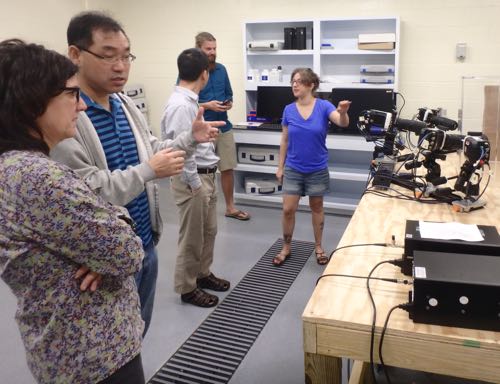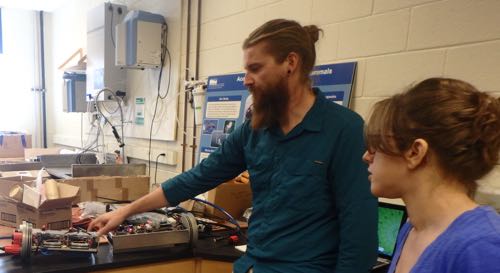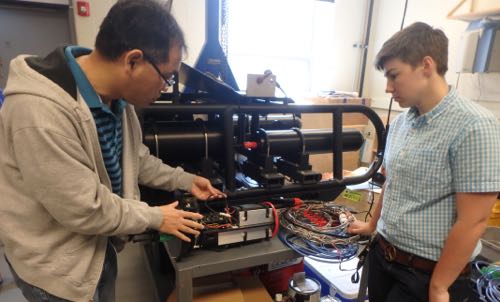"Good data come with lots of effort," was how Hongsheng Bi, Principal Investigator, summed up Day One of logistical planning for the Jellyfish in the Bering Sea expeditions. The research will be conducted in two field seasons, beginning with this year's cruises to the Bering Sea. The first one is scheduled for 27 May - 2 June, and the second one is slated for 29 July - 4 August, 2017. There will be two more cruises next year.
 Mary Beth Decker, Hongsheng Bi and the rest of the team examine equipment.
Mary Beth Decker, Hongsheng Bi and the rest of the team examine equipment.
 Ben and Suzan discuss the ARIS1800.
Ben and Suzan discuss the ARIS1800.
Present at the scenic campus of the Chesapeake Biological Laboratory at the University of Maryland Center for Environmental Science for the logistics meeting were Principal Investigator Mary Beth Decker, Hongsheng Bi, Dong Liang (Research Assistant Professor in Environmental Statistics), Katie Lankowicz (graduate student in Ecological Systems), Suzan Shahrestani (PhD candidate in Fisheries Science), Benjamin Binder (PhD candidate in Goliath grouper research and acoustics at Florida International University), and me. Each member of the team was engaged in the planning. Much time during the meeting was given to deciding the exact transects to be sampled and sampling methods. Dong Liang evaluated the proposals and the statistics needed to analyze them. The instruments used for sampling were exhibited and demonstrated for all, as we will be taking turns changing batteries and hard drives on them during the expedition.
 Hongsheng and Katie work on the ZOOVIS.
Hongsheng and Katie work on the ZOOVIS.
Hongsheng and Katie showed the team how to handle the ZOOVIS, a large underwater optical system which can capture 15 full frames every second. This advanced optical imaging system, developed by Hongsheng, can sample small jellyfish in their early stages when they are less than three centimeters. Larger jellyfish will be sampled by the ARIS1800, an advanced sonar-based imaging system to be deployed on the expedition and was demonstrated by Benjamin and Suzan. Using both these systems, as well as net sampling, we will be able to effectively sample jellyfish to determine spatial distribution and abundances. As for my role, I will be planning educational outreach for the public aboard the ships and for my students upon my return. Both Mary Beth and Hongsheng generously offered to help me with materials from the expedition for outreach and classroom instruction.
As I departed the picturesque campus of the Chesapeake Biological Laboratory at the University of Maryland Center for Environmental Science, I reflected on how the careful planning and attention to detail discussed during our logistics meeting will lend itself to sound research. I count myself fortunate to have participated in the planning for the expedition and to be part of a team which adheres to sound science.


Comments
Add new comment